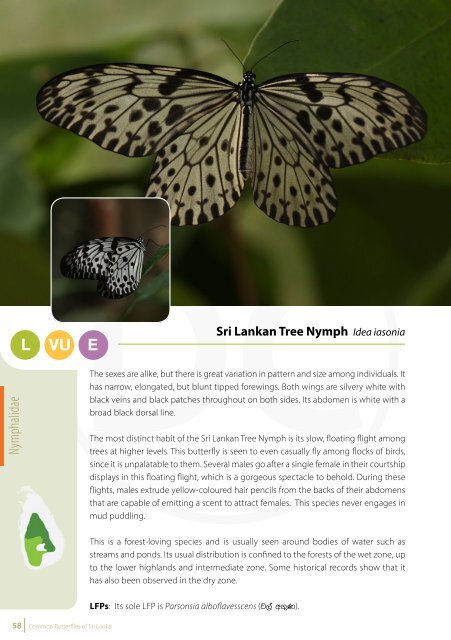Common Butterflies of Sri Lanka
Common Butterflies of Sri Lanka
Common Butterflies of Sri Lanka
You also want an ePaper? Increase the reach of your titles
YUMPU automatically turns print PDFs into web optimized ePapers that Google loves.
<strong>Sri</strong> <strong>Lanka</strong>n Tree Nymph Idea iasonia<br />
Blue Glassy Tiger Ideopsis similis<br />
L VU E<br />
M VU<br />
Nymphalidae<br />
The sexes are alike, but there is great variation in pattern and size among individuals. It<br />
has narrow, elongated, but blunt tipped forewings. Both wings are silvery white with<br />
black veins and black patches throughout on both sides. Its abdomen is white with a<br />
broad black dorsal line.<br />
The most distinct habit <strong>of</strong> the <strong>Sri</strong> <strong>Lanka</strong>n Tree Nymph is its slow, floating flight among<br />
trees at higher levels. This butterfly is seen to even casually fly among flocks <strong>of</strong> birds,<br />
since it is unpalatable to them. Several males go after a single female in their courtship<br />
displays in this floating flight, which is a gorgeous spectacle to behold. During these<br />
flights, males extrude yellow-coloured hair pencils from the backs <strong>of</strong> their abdomens<br />
that are capable <strong>of</strong> emitting a scent to attract females. This species never engages in<br />
mud puddling.<br />
This is a forest-loving species and is usually seen around bodies <strong>of</strong> water such as<br />
streams and ponds. Its usual distribution is confined to the forests <strong>of</strong> the wet zone, up<br />
to the lower highlands and intermediate zone. Some historical records show that it<br />
has also been observed in the dry zone.<br />
The sexes are alike. The background colour on the upper surface <strong>of</strong> its wings is black,<br />
while the underside is brown. The markings on its forewing are blue, while those on<br />
its hind wing are glass white. The differences in these colours are prominent on the<br />
underside. These markings are similar in shape on both the upper and lower surfaces.<br />
Its forewing cell has a basal streak and a large spot distally. Three other lines radiate<br />
from the base <strong>of</strong> the forewing with one thin line above the cell and two broad lines<br />
below.<br />
The Blue Glassy Tiger has a moderately fast, casual flight. It prefers to fly about 5 feet<br />
above the ground but readily comes down to the long panicled flowers <strong>of</strong> herbaceous<br />
plants for nectar. When they settle on these flowers, they adopt a hang-up position<br />
since the panicle cannot withstand their weight. They go to higher levels for basking<br />
and roosting.<br />
This butterfly can be commonly seen in both forests and verdant home gardens,<br />
but its distribution is restricted to the western parts <strong>of</strong> the country ranging from<br />
Negombo to Matara.<br />
Nymphalidae<br />
LFPs: Its sole LFP is Parsonsia alb<strong>of</strong>lavesscens (j,a w.=K).<br />
LFPs: Larvae have been successfully reared only on Tylophora indica<br />
58 <strong>Common</strong> <strong>Butterflies</strong> <strong>of</strong> <strong>Sri</strong> <strong>Lanka</strong><br />
<strong>Common</strong> <strong>Butterflies</strong> <strong>of</strong> <strong>Sri</strong> <strong>Lanka</strong> 59















